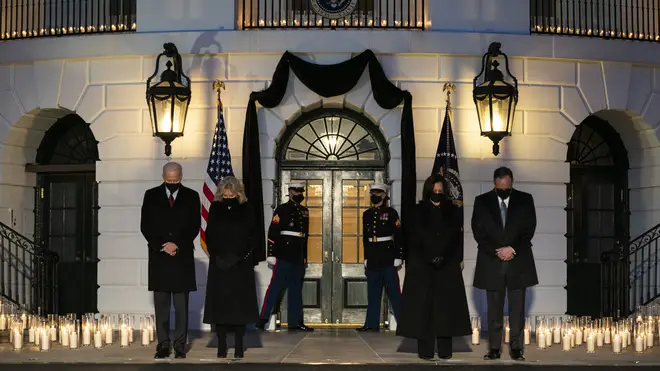
Nick Abbot 12am - 1am
23 February 2021, 09:04

The grim milestone, as recorded by Johns Hopkins University, comes as states redouble efforts to get the coronavirus vaccine into arms.
The Covid-19 death toll in the US has topped 500,000, a staggering number that all but matches the number of Americans killed in the Second World War, Korea and Vietnam combined.
President Joe Biden held a sunset moment of silence and a candle-lighting ceremony at the White House and ordered American flags to be lowered at federal buildings for the next five days.
“We have to resist becoming numb to the sorrow,” Mr Biden said. “We have to resist viewing each life as a statistic or a blur.”
The grim milestone, as recorded by Johns Hopkins University, comes as states redouble efforts to get the coronavirus vaccine into arms after last week’s winter weather closed clinics, slowed vaccine deliveries and forced tens of thousands of people to miss their shots.
Despite the rollout of vaccines since mid-December, a closely watched model from the University of Washington projects more than 589,000 dead by June 1.
The US toll is by far the highest reported in the world, accounting for 20% of the nearly 2.5 million coronavirus deaths globally, though the true numbers are thought to be significantly greater, in part because many cases were overlooked, especially early in the outbreak.
The first known deaths from the virus in the US were in early February 2020. It took four months to reach the first 100,000 deaths. The toll hit 200,000 in September and 300,000 in December, then took just over a month to go from 300,000 to 400,000 and another month to climb from 400,000 to 500,000.
The US recorded an estimated 405,000 deaths in the Second World War, 58,000 in the Vietnam War and 36,000 in the Korean War.
“Today, I ask all Americans to remember — remember those we lost and those who are left behind.” — President Biden on the more than 500,000 lives lost to COVID-19 pic.twitter.com/KtABRcpLHH
— The White House (@WhiteHouse) February 23, 2021
Average daily deaths and cases have plummeted in the past few weeks. Virus deaths have fallen from more than 4,000 reported on some days in January to an average of fewer than 1,900 per day.
But experts warn that dangerous variants could cause the trend to reverse itself. And some experts say not enough Americans have been inoculated yet for the vaccine to be making much of a difference.
Instead, the drop-off in deaths and cases has been attributed to the passing of the holidays; the cold and bleak days of midwinter, when many people stay home; and better adherence to mask rules and social distancing.
Dr Ryan Stanton, an emergency room doctor in Lexington, Kentucky, who has treated scores of Cocid-19 patients, said he never thought the US deaths would be so high.
“I was one of those early ones that thought this may be something that may hit us for a couple months… I definitely thought we would be done with it before we got into the fall. And I definitely didn’t see it heading off into 2021,” Dr Stanton said.

Snow, ice and weather-related power outages closed some vaccination sites and held up shipments across a large swathe of the nation, including in the Deep South.
As a result, the seven-day rolling average of administered first doses fell by 20% between February 14 and 21, according to data from the Centres for Disease Control and Prevention.
The White House said that about a third of the roughly six million vaccine doses delayed by bad weather were delivered over the weekend, with the rest expected to be delivered by mid-week, several days earlier than originally expected.
White House coronavirus response co-ordinator Andy Slavitt on Monday attributed the improved timeline to an “all-out, round-the-clock” effort over the weekend that included employees at one vaccine distributor working night shifts to pack vaccines.
More than 44 million Americans have received at least one dose of either the Pfizer or Moderna vaccine, and about 1.6 million per day received either a first or second dose over the past seven days, according to officials.

The nation’s supply could expand significantly if health regulators approve a single-shot Covid-19 vaccine developed by Johnson & Johnson.
The company said it will be able to provide 20 million US doses by the end of March if it gets the green light, and would have capacity to provide 100 million vaccine doses to the US by the end of June.
That supply will help government officials reach the goal of having enough injections to vaccinate most adult Americans later this year. On a global scale, the company aims to produce one billion doses this year.